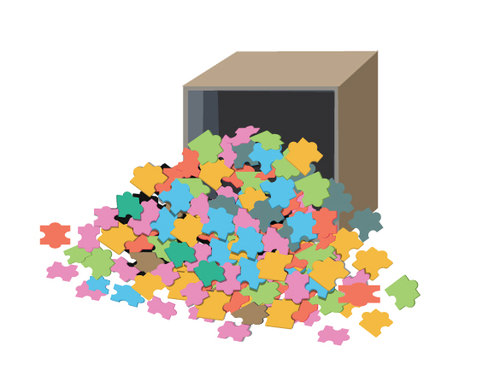18.13 分子性
章节大纲
-
One piece at a time
::一块一块一块一块一块一块一块一块Many people enjoy putting jigsaw puzzles together. Often these puzzles come in a box, so you have to spread all the pieces out before you start. Nowadays you can also find internet sites that have jigsaw puzzles. You can choose the level of difficulty, the shape of the pieces – and you can time yourself to see how well you did compare to others that tried the puzzle. The puzzle looks complicated with the final product often numbering hundreds of pieces. However, in assembling the puzzle, you have a series of elementary steps and the puzzle goes together one piece at a time.
::许多人喜欢将拼图拼图拼在一起。 这些拼图通常会放在一个盒子里, 所以您必须在开始之前将所有的拼图都散开。 现在您也可以找到有拼图拼图的互联网网站。 您可以选择困难程度 — — 拼图的形状 — — 也可以用时间来查看您和尝试拼图的其他人相比的成绩。 拼图看起来复杂得多, 最终的拼图往往有成百上千块。 然而, 在拼图的过程中, 您有一系列基本步骤, 拼图会同时拼在一起 。Molecularity of a Reaction
::反应的分子性The molecularity of a reaction is the number of molecules reacting in an elementary step . A unimolecular reaction is one in which only one reacting molecule participates in the reaction. Two reactant molecules collide with one another in a bimolecular reaction. A termolecular reaction involves three reacting molecules in one elementary step. Termolecular reactions are relatively rare because they involve the simultaneous collision of three molecules in the correct orientation, a rare event. When termolecular reactions do occur, they tend to be very slow.
::反应的分子性是指在基本步骤中反应的分子数量。非分子性反应是指只有一个反应分子参与反应的分子数量。两种反应分子在双分子反应中相互碰撞。一个术语分子性反应涉及三个反应分子,一个基本步骤中的三个反应分子。分子性反应相对较少,因为它们涉及三个分子在正确方向上同时碰撞,这是一个罕见的事件。当分子性反应发生时,它们往往非常缓慢。If we have the reaction:
::如果我们有反应:
::2NO(g)+O2(g)+O2(g)We might guess that the reaction was termolecular since it appears that three molecules of reactants are involved. However, our definition of molecularity states that we need to look at an elementary step and not the overall reaction. Data on the reaction mechanism shows us that the reaction occurs in two steps:
::我们也许可以猜想,反应是分子一词,因为似乎涉及到三个反应分子的分子。然而,我们对分子的定义表明,我们需要看一个基本步骤,而不是整体反应。 关于反应机制的数据告诉我们,反应分为两个步骤:Step 1:
::步骤1:2NO(g)N2O2(g)Step 2:
::第2步:N2O2(g)+O2(g)So we see that each elementary step is bimolecular and not termolecular. Notice that the colliding molecules may be the same (as in step 1 above) or different (as in step 2 above).
::因此我们看到每个基本步骤都是双分子而不是术语分子。 注意相撞的分子可以是相同的(如以上步骤1)或不同的(如以上步骤2)或不同的(如以上步骤2)。Another reaction involves the conversion of ozone (O 3 ) to oxygen (O 2 ) with ultraviolet light. The two elementary steps are as follows:
::另一种反应是用紫外光将臭氧(O3)转化为氧(O2)。
::O3+紫外光光2+O(无自由基)慢反应OO3+紫外光2O2快速反应The first step is unimolecular (one molecule of ozone reacts) and the second step is bimolecular (one ozone free radical and one ozone molecule react together).
::第一步是非分子(一个臭氧反应分子),第二步是双分子(一个无臭氧激进分子和一个臭氧分子一起反应)。Summary
::摘要-
Molecularity is defined and examples are given.
::界定了分子性,并提供了实例。
Review
::回顾-
What is a unimolecular reaction?
::什么是非分子反应? -
What is a bimolecular reaction?
::什么是双分子反应? -
Why are termolecular reactions rare?
::为什么分子反应一词很少?
-
Molecularity is defined and examples are given.
